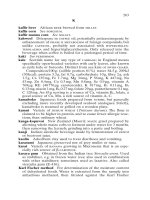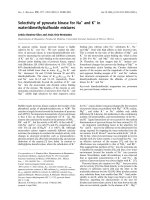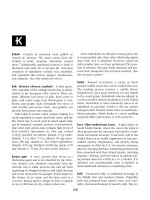Anderson Amalan Kumar and K. Krishna Surendar
Bạn đang xem bản rút gọn của tài liệu. Xem và tải ngay bản đầy đủ của tài liệu tại đây (224.25 KB, 6 trang )
Int.J.Curr.Microbiol.App.Sci (2019) 8(10): 905-910
International Journal of Current Microbiology and Applied Sciences
ISSN: 2319-7706 Volume 8 Number 10 (2019)
Journal homepage:
Original Research Article
/>
Physiological Basis of Screening Rice Varieties for
Low Temperature Stress Tolerance
Anderson Amalan Kumar1* and K. Krishna Surendar2
1
Department of Crop Physiology, AC & RI, TNAU, Kudumiyanmalai, India
2
Department of Crop Physiology, AC & RI, TNAU, Coimbatore, India
*Corresponding author
ABSTRACT
Keywords
Rice, Low
temperature,
Morphological,
Physiological and
yield
Article Info
Accepted:
10 September 2019
Available Online:
10 October 2019
A field experiment was conducted at the Regional Research Station, Paiyur main farm
with the varieties viz., ADT 38, ADT 39, ADT 43, Anna 4, Bhavani, BPT 5204, CO43, IR
20, IR 42, IR 50, K 429, Karuppunel, Kottanel, MDU 3, MDU 4, MDU 5, Paiyur 1, PS 1,
PS 2,PS 3, Savulu samba and White Ponni The experiment was designed for screening the
rice cultivars for low temperature stress tolerance through the physiological and
biochemical responses. The experiment was laid out in RBD with three replications and
twenty two varieties. The rice seedlings were transplanted in the main field with the
spacing of 22.5 x 22.5cm during late sampa season (October 2014). The results of
experiment explained that maximum plant height was observed in Kottanel and
Doddabayarunel and root length was maximum in ADT 38 and was followed by Paiyur 1
and Bhavani at 0th DAT. At 30 DAT maximum plant height was observed in Kottanel.
Root length was maximum in BPT 5204 maximum number of tillers was observed in ADT
38 and was followed by IR 20 which recorded highest number of leaves per plant. At 60
DAT, maximum plant height was observed in Karuppunel. Root length was maximum in
Bhavaniand maximum number of tillers was observed in IR 20.Anna 4 which recorded
highest number of leaves per plant. At 90 DAT, maximum plant height was observed in
DBN. Root length was maximum in White ponniand maximum number of tillers was
observed in PS 3.Maximum grain yield ha-1 was recorded in the variety MDU 3 and was
closely followed by MDU 4 and CO 43 and were on par with each other.
Introduction
Rice (Oryza sativa L.) is an important food
crop of India. The cultivated rice originated in
the South East Asia. Rice is the most
important cereal crop because of its use as
prime food in many countries of world. Rice is
mainly grown during kharif but in some areas
it is also grown during rabi. Rabi paddy is
usually sown in the month of November to
January that coincides with winter season in
North India, and the cold adversely affect the
rabi rice germination, growth at seedling
stages, tillers formation and fertility and
ultimately affecting yield. Rice plants are
susceptible to low temperature during the
905
Int.J.Curr.Microbiol.App.Sci (2019) 8(10): 905-910
young microspore primordial stage, which
occurs 10–12 days before heading. Low
temperature during seedling and vegetative
growth stage of rice crop affects germination,
formation of seedling, plantlet chlorosis,
mortality and prolongs the duration of the crop
and it effects the transplanting of subsequent
autumn rice crop. Research findings shows
that critical low temperatures can be damage
germination to maturity stage. The critical
temperature for rice is usually below 20°C and
varies according to growth stage, for example,
for germination, the critical temperature is
10°C and for the reproductive stage, it is 17°C
(Li et al., 2011; Mackill and Lei, 1997). A
plant can endure through two types of injuries
after low temperature exposure. Chilling
injury occurs due to lower temperature just
above freezing point of water.
This phenomenon remains reversible initially
but ultimately causes cell death due to
prolonged cold spell. Sometimes the
progressive colder temperature beyond critical
range may result in hardening and/or
acclimatization of plants which can lessen
and/or abolish stress injury. Freezing injury is
induced by the low temperature below
freezing point. The intracellular freezing
becomes fatal for the protoplasmic structure
when the ice crystals grow large enough to
disrupt the cells. In extra cellular freezing, the
protoplasm of the plant becomes dehydrated
because a water vapour deficit is created as
cellular water is transferred to ice crystals
formed in the intercellular spaces. Rice crop is
more commonly abused by the chilling injury.
Thus, this experiment was designed for
screening the rice cultivars for low
temperature stress tolerance through the
physiological and biochemical responses.
Plant height, root length, number of tillers,
Crop growth rate and relative growth rate,
disintegration of cellular membranes and
response of photosynthetic pigments will be
taken in to consideration to assess the
response of the various rice cultivars to low
temperature condition from this experiment.
Materials and Methods
A field experiment was conducted at the RRS
main farm with the varieties viz., ADT 38,
ADT 39, ADT 43, Anna 4, Bhavani, BPT
5204, CO43, IR 20, IR 42, IR 50, K 429,
Karuppunel, Kottanel, MDU 3, MDU 4, MDU
5, Paiyur 1, PS 1, PS 2,PS 3, Savulu samba
and White Ponni with three replications were
laid out in Randomized Block Design. The
experiment was designed for screening the
rice cultivars for low temperature stress
tolerance through the physiological and
biochemical responses.
The rice seedlings were transplanted in the
main field with the spacing of 22.5 x 22.5cm
during late sampa season (October 2014).
Morphological characters like plant height,
root length, number of tillers and number of
leaves were recorded at 0, 30, 60 and 90 DAT
(Days After Transplanting). The growth
attributes characters viz., Crop Growth Rate
(CGR) and Relative Growth Rate (RGR) were
measured at 0-90 DAT. The straw and grain
yield ha-1was assessed at the time of
harvesting.
Results and Discussion
Plants require an optimal temperature range
for their growth, development and ultimate
survival45. Low temperature has a strong
impact on growth, survival, reproduction and
distribution of plants. The seedlings get
severely damaged by cold stress when they are
grown in winter environments (Nishiyama,
1985).
In this present study, morphological
observations were recorded at 0, 30, 60 and 90
DAT. At 0 DAT, significant difference was
906
Int.J.Curr.Microbiol.App.Sci (2019) 8(10): 905-910
observed among varieties for plant height and
root length. Maximum plant height (26.0 cm)
was
observed
in
Kottanel
and
Doddabayarunel. Root length was maximum
in ADT 38 (6.6cm) and was followed by
Paiyur 1 and Bhavani (5.7 cm) (Table 1).
Rice is still a tropical C3 crop, which yields
best under warm temperatures and high solar
radiation (Karki et al., 2013). It is been
reported to be more sensitive to cold stress
than any other cereal crops, especially during
seedling, tillering, panicle development and
flowering stages (Mukhopadhyay et al., 2004).
The critical temperature for rice growth
diverges with different developmental phases
such as 10°C for germination and 17°C for the
reproductive stages.
Table.1 Effect of low temperature stress on plant height, root length, number of tillers and
number of leaves and yield of rice entries at different stages
0 DAT
Root length
(cm)
ADT 38
ADT 39
ADT 43
12.8
3.5
45.3
18.3
7.0
24.0
Anna 4
17.8
3.0
56.0
16.0
8.0
25.7
Bhavani
23.9
5.7
46.0
15.3
7.7
22.7
BPT 5204
16.1
4.0
55.3
23.0
7.7
25.3
CO 43
14.4
3.8
44.3
16.0
8.3
28.0
IR 20
17.8
2.8
50.7
16.0
10.7
35.0
DBN
26.0
3.7
60.7
15.3
7.3
26.7
IR 50
19.3
3.2
45.3
16.7
9.7
30.0
K 429
23.5
4.1
49.7
17.7
8.0
29.3
Karuppunel
23.4
2.5
54.3
10.3
5.7
23.0
Kottanel
26.0
4.8
63.0
13.3
9.0
29.0
MDU 3
MDU 4
MDU 5
Paiyur 1
15.0
16.8
15.6
19.0
4.1
3.8
3.4
5.7
44.0
51.7
42.7
44.0
14.3
19.0
12.7
13.3
6.3
5.0
6.7
8.0
25.3
19.3
24.0
24.7
PS 1
PS 2
PS 3
Savulu samba
20.6
17.5
23.4
21.0
3.8
2.7
3.5
3.0
50.0
53.7
53.0
62.7
18.0
19.0
17.3
17.7
6.7
8.7
8.7
9.7
21.0
27.7
17.7
32.3
White Ponni
19.6
4.7
50.3
9.0
9.0
24.7
SE (d)
CD 0.05
1.4
2.8
0.2
0.4
4.2
8.4
1.0
2.1
0.4
0.8
2.4
4.9
Variety
6.6
3.3
Plant
height
(cm)
48.0
49.3
Root
length
(cm)
22.7
15.0
30 DAT
No. of
tillers /
plant
11.7
10.0
Plant
height
(cm)
22.2
19.4
907
No. of
leaves /
plant
31.7
32.7
Int.J.Curr.Microbiol.App.Sci (2019) 8(10): 905-910
Table.2 Effect of low temperature stress on plant height, root length, number of tillers and
number of leaves and yield of rice entries at different stages
60 DAT
Root
No. of
length tillers /
(cm)
plant
13.0
7.0
11.3
10.3
No. of
leaves /
plant
27.0
35.0
Plant
height
(cm)
71.3
69.3
90 DAT
Root
No. of
length
tillers /
(cm)
plant
16.0
7.0
13.0
12.3
ADT 38
ADT 39
Plant
height
(cm)
58.3
63.7
ADT 43
50.0
12.0
9.0
22.7
77.7
12.0
7.0
7.0
Anna 4
70.0
15.7
15.0
49.0
60.7
8.0
10.0
8.3
Bhavani
62.0
20.0
11.3
44.7
90.7
14.0
7.0
7.0
BPT 5204
60.3
13.0
6.0
18.0
64.0
10.3
10.0
8.0
CO 43
61.0
17.0
8.0
36.7
89.3
8.0
7.3
7.0
IR 20
56.3
12.0
16.0
45.0
77.0
16.0
12.0
7.3
DBN
96.0
10.3
8.0
29.7
110.0
13.0
10.0
9.0
IR 50
59.0
16.0
9.3
33.0
60.0
10.3
12.3
8.0
K 429
68.0
14.0
8.0
36.0
89.0
11.0
11.0
11.0
Karuppunel
106.0
8.0
8.0
26.0
90.3
9.0
9.7
8.0
Kottanel
99.3
7.0
7.0
21.3
94.0
12.7
9.0
7.0
MDU 3
66.0
10.3
11.0
39.0
90.0
13.3
14.0
14.0
MDU 4
63.0
14.0
11.7
46.3
84.7
14.3
8.3
8.0
MDU 5
60.3
15.0
8.0
34.3
62.7
11.0
9.0
9.0
Paiyur 1
47.0
15.0
6.0
29.3
65.0
11.0
9.0
7.3
PS 1
83.0
12.0
8.0
33.0
80.0
17.0
8.0
6.3
PS 2
59.0
14.7
9.0
42.0
83.7
14.7
13.0
12.3
PS 3
53.7
11.0
11.7
29.7
62.0
6.0
15.0
13.0
Savulu samba
100.0
12.0
7.7
26.3
102.0
13.3
6.3
6.0
White Ponni
68.0
14.3
11.0
42.0
103.3
20.0
14.0
8.3
SE (d)
5.0
0.6
0.5
2.1
4.9
0.8
0.7
0.5
CD 0.05
10.1
1.2
1.0
4.2
9.9
1.5
1.5
0.9
Variety
908
No. of
panicles /
plant
7.0
10.0
Int.J.Curr.Microbiol.App.Sci (2019) 8(10): 905-910
Table.3 Effect of low temperature stress on growth attributes and yield of rice entries
Variety
ADT 38
CGR
RGR
(g/m2/day)
(g/g/day)
0-90 DAT
3.667
0.076
Yield per hectare
(kg/ha)
Straw yield
Grain yield
7187
4930
Harvest
index
40.7
ADT 39
5.320
0.087
4984
2972
37.4
ADT 43
4.206
0.101
8050
4329
35.0
Anna 4
4.456
0.091
6791
2961
30.4
Bhavani
6.179
0.094
8301
4430
34.8
BPT 5204
5.593
0.098
5095
2416
32.2
CO 43
5.532
0.099
8341
5215
38.5
IR 20
5.965
0.098
7601
4279
36.0
DBN
5.630
0.091
8413
3693
30.5
IR 50
3.249
0.090
6692
1404
17.3
K 429
6.117
0.083
6470
2984
31.6
Karuppunel
3.640
0.092
5976
3196
34.8
Kottanel
3.761
0.084
6479
2480
27.7
MDU 3
7.478
0.103
9073
6015
39.9
MDU 4
5.776
0.098
7984
5261
39.7
MDU 5
3.258
0.092
7581
2114
21.8
Paiyur 1
4.667
0.078
6273
2222
26.2
PS 1
4.851
0.088
5261
3236
38.1
PS 2
8.128
0.105
6025
4127
40.7
PS 3
2.799
0.082
6416
2099
24.7
Savulu samba
4.017
0.094
7970
2382
23.0
White Ponni
SE (d)
CD 0.05
6.390
0.386
0.780
0.099
0.007
0.014
9502
1012
2044
3960
427
862
29.4
-
Temperature drops to about 10°C during
seedling establishment (October to early
November) such low temperature significantly
reduces seedling growth and establishment
(Humphreys et al., 1996). In this present
study, At 30 DAT maximum plant height
(63.0 cm) was observed in Kottanel. Root
length was maximum in BPT 5204 (23.0cm)
Maximum number of tillers (11.7) was
observed in ADT 38 and was followed by IR
20 which recorded highest number of leaves
per plant.
At 60 DAT, significant difference between the
varieties was observed for the parameters
studied. Maximum plant height (106.0 cm)
was observed in Karuppunel. Root length was
maximum in Bhavani (20.0cm). Maximum
909
Int.J.Curr.Microbiol.App.Sci (2019) 8(10): 905-910
number of tillers (16.0) was observed in IR 20
and was closely followed by Anna 4 which
recorded highest number of leaves per plant.
At 90 DAT, maximum plant height (110.0 cm)
was observed in DBN. Root length was
maximum in White ponni (20.0cm) Maximum
number of tillers (15.0) was observed in PS 3
and was closely followed by White Ponni and
MDU 3 (Table 2).
The
morphological
adaptations
with
decreasing temperature are often linked to
decrease in leaf area ratio (LAR), specific leaf
area (SLA) and relative growth rate (RGR).
Increase in leaf thickness is an adaptation
mechanism to protect the photosynthetic
machinery against the cold (Verheulet al.,
1996). Rice genotypes having high respiratory
homeostasis (H), i.e. an ability of the plants to
maintain similar respiration rates at growth
temperatures, showed greater tolerance and
maintained both shoot and root growth under
cold conditions.
In this present study, the mean crop growth
rate and relative growth rate between 0- 90
DAT was the highest in the variety PS2 and
was closely followed by MDU3 (Table 3).
Significant difference was observed for straw
yield and grain yield among the varieties
tested for low temperature stress tolerance.
Straw yield was maximum in White Ponni.
However maximum grain yield per hectare
was recorded in the variety MDU3 and was
closely followed by MDU4 and CO43 and
were on par with each other. Among the
twenty two varieties tested for low
temperature stress tolerance, the variety
MDU3 performed better than other varieties.
MDU4 and CO43 were on par with MDU3.
References
Humphreys, L., Sides, R. and Fattore, A., Rice
establishment. Farmers' News letter
Large Area, 147: 30-31 (1996).
Karki, S., Rizal, G. and Quick, W.P.,
Improvement of photosynthesis in rice
(Oryza sativa L.) by inserting the C4
pathway.
Rice
6:
28.
doi:
10.1186/1939-8433-6-28.
pmid:24280149 (2013)
Li, H.W., Zang, B.S., Deng, X.W. and Wang,
X.P., Overexpression of the trehalose6-phosphate synthase gene OsTPS1
enhances abiotic stress tolerance in
rice. Planta, 234: 1007–1018 (2011).
Mackill, D.J. and Lei, X.M., Genetic variation
for traits related to temperate
adaptation of rice cultivars. Crop
Science, 37: 1340-1346 (1997).
Mukhopadhyay, A., Vij, S. and Tyagi, A.K.,
Overexpression of a zinc-finger protein
gene from rice confers tolerance to
cold, dehydration, and salt stress in
transgenic tobacco. ProcNatlAcad Sci.,
101: 6309–6314 (2004).
Nishiyama, I., Physiology of Cool Weather
Damage to the Rice Plant. Sapporoo,
Japan, Hokkaido University Press
(1985).
Verheul, M.J., Picatto, C. and Stamp, P.,
Growth and development of maize
(Zea mays L.) seedlings under chilling
conditions in the field. European
Journal of Agronomy, 5: 31-43 (1996).
How to cite this article:
Anderson Amalan Kumar and Krishna Surendar, K. 2019. Physiological Basis of Screening
Rice Varieties for Low Temperature Stress Tolerance. Int.J.Curr.Microbiol.App.Sci. 8(10):
905-910. doi: />
910









